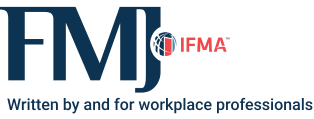Not If, but When
Getting the most ROI through leak detection

Philosopher Benjamin Franklin famously said nothing is certain except death and taxes. If he were alive today, he might amend his famous quote to say, “Nothing is certain except death, taxes and water leaks ruining your week.”
Water leaks are practically inevitable for a facility or property manager. According to data compiled by Angi.com based on thousands of actual projects sourced through their website, the average water damage restoration project costs US$3,838 — and this figure is geared more toward homes than business facilities. Multiply this number by several factors, such as the number of sinks, toilets, water heaters and other systems, to understand the possible scale of a building’s exposure to water leak issues. Leaks often go undetected until they become major issues because most water leaks happen in out of the way spots not often checked: in a cabinet, behind an appliance, or in a basement or crawl space.
Leaks can occur in dozens of places throughout a facility. According to Chubb Insurance, the most common culprits in commercial facilities include:
-
HVAC systems: Condensate drain line clogs cause pans to overflow; frozen coils create moisture buildups.
-
Hot water heaters & boilers: Valve leaks or corrosion can release water silently.
-
Kitchenettes: Dishwashers, ice makers and coffee makers often suffer supply line leaks and clogged drains.
-
Bathroom sinks: Flexible hoses and connections drip slowly, rotting cabinetry and walls.
-
Pipes, valves & joints: Hard water accelerates deterioration faster than expected.
And failure to address leaks early can lead to the following types of remediation:
-
Flooring replacement: Warped hardwood, lifted tile, soaked carpets.
-
Drywall & ceiling repair: Leaks travel invisibly behind walls and overhead.
-
Mold remediation: Even a pinhole leak breeds costly, hazardous mold.
-
Electrical hazards: Shorts, outages or even fires near wiring and servers.
-
Operational downtime: Kitchens, patient rooms or server clusters offline, which means lost revenue and perhaps a downgrade in reputation.
Overview of water leak detection solutions
Deciding which solution is right for a facility depends on numerous factors, including the type and value of assets at risk (from living spaces to patient rooms to server clusters), the number of water-using appliances and systems in operation, the reliability of on-site Wi-Fi or monitoring staff, insurance premium considerations, and the level of tolerance a business has for downtime or disruption.
|
Water Leak Detection Category |
Approximate Cost* |
Pros |
Cons |
|
Stand-Alone Alarms |
Starting at $5/unit |
Lowest cost, no wiring or Wi-Fi setup, easily scalable across dozens or hundreds of spaces |
Does not connect to Wi-Fi or shut off water automatically |
|
Wi-Fi Enabled |
Starting at $20/unit |
Can notify staff remotely, integrates with smart building systems |
Requires stable Wi-Fi connection, plugged-in hub and battery maintenance, prone to disconnections |
|
Automatic Shutoff Valves |
Starting at $500/unit |
Stops leaks at the source, especially for high-risk appliances (water heaters, boilers) |
High upfront cost, plumbing installation required |
|
Advanced Enterprise Systems |
Starting at $1,000 |
Centralized monitoring, analytics, 24/7 professional support |
Expensive and time-consuming installation, ongoing service fees |
*Prices in USD
Do the math
Investing in water leak detection is one of the highest return-on-investment (ROI) activities for a business.
Think of leak detection as insurance that pays for itself almost immediately. Use the guide below to help calculate the ROI for a facility.
-
Risk Points: Count all leak risk points (e.g. sinks, heaters, AC units) in a facility; 10 sinks + 2 heaters + 3 AC units = 15 potential leaks
-
Odds of a leak happening in a single location over 3 years = 10 percent
-
Expected number of leaks (A times B): 10 percent times 15 locations = 1.5 expected leaks over 3 years
-
Average damage per leak = $3,000
-
Expected damage from leaks (C times D) = $3,000 x 1.5 = $4,500
-
Cost of detection: 15 simple alarms at $8 each = $120
-
ROI (E divided by F) = 37.5x
If even one leak is prevented, a company can reap nearly 40 times their ROI in year one. This math is why insurers require leak detection for certain facilities or offer premium discounts when they are installed, just as they do with sprinkler systems.
Drip, drip, drip…
Searching for news stories on the topic of water leaks yields numerous examples of facilities that experienced leaks and incurred significant costs and downtime to remedy the damage.
- A Bakersfield hotel had a slow leak under a sink, leading to mold growth and seepage into the floor below. It required thousands of dollars in remediation and made several rooms inhospitable and out of service for weeks.
- A Kansas server facility had a clogged condensate drain lead to an overflow back into the unit and surrounding area, eventually shorting out multiple servers and disrupting operations.
- A Miami restaurant with an undetected roof leak, which caused a section of ceiling to collapse onto diners, injuring nine people. Lawsuits are still pending.
Time is dripping away, and prevention is easier than ever. Facility managers should start with the most cost-effective solution possible and work up to more expensive solutions if needed. Baseline solutions are inexpensive, and many companies offer bulk purchasing discounts for businesses; so, there is no reason not to inquire about the initial cost to protect a facility. Leaks are not an if, but a when. By understanding the investment in detection compared to what an organization stands to lose, FMs can ensure their buildings stay operational, resilient and safe. When that happens, their organizations stand to profit and avoid costly remediation, possible litigation and a hit to the reputation.

Read more on Risk Management and Finance & Business or related topics Return on Investment (ROI) , Furniture, fixtures and equipment (FF&E) and Building Systems
Explore All FMJ Topics









